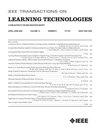数字教师外表拟人化如何影响数字学习满意度和使用意愿:与知识类型的互动
IF 4.9
3区 教育学
Q2 COMPUTER SCIENCE, INTERDISCIPLINARY APPLICATIONS
引用次数: 0
摘要
数字教师代表了在线教育环境中媒体和人工智能(AI)的创新融合。然而,数字教师的外表拟人化影响不同知识类型传递的具体方式仍未得到充分的了解。基于具身学习理论和准社会互动理论,本研究探讨了数字教师的外表(卡通化与现实化)与知识类型(显性与隐性)的相互作用如何影响数字学习满意度和使用意愿,并探讨了身体存在和社会存在的中介作用。最初,我们使用大型语言模型应用程序实施了2 × 2实验设计,收集了来自475名参与者的数据来实证检验我们的假设。随后,对21名中国大学生进行了深入访谈,以进一步验证和阐明这些互动背后的潜在机制。结果表明,具有卡通形象的数字化教师在传递显性知识方面更有效,而具有逼真形象的数字化教师在传递隐性知识方面更出色。身体存在和社会存在都能显著调节这些影响。本研究通过突出数字教师形象与所传授的知识类型之间的一致性效应以及揭示潜在的心理机制,丰富了我们对人工智能增强的在线教育的理解。此外,它还为教育界面和更广泛的人工智能交互场景中的数字人的外观设计提供了实用的见解。本文章由计算机程序翻译,如有差异,请以英文原文为准。
How Digital Teacher Appearance Anthropomorphism Impacts Digital Learning Satisfaction and Intention to Use: Interaction With Knowledge Type
Digital teachers represent an innovative fusion of media and artificial intelligence (AI) within online educational environments. However, the specific ways in which the appearance anthropomorphism of digital teachers influences the delivery of different knowledge types remain insufficiently understood. Drawing on Embodied Learning Theory and Parasocial Interaction Theory, this study investigates how digital teachers' appearance (cartoonish versus realistic) interacts with knowledge types (explicit versus tacit) to affect digital learning satisfaction and usage intention, exploring the mediating roles of physical and social presence. Initially, we implemented a 2 × 2 experimental design using a large language model application, collecting data from 475 participants to empirically test our hypotheses. Subsequently, in-depth interviews were conducted with 21 Chinese university students to further validate and clarify the underlying mechanisms behind these interactions. The results indicate that digital teachers with a cartoonish appearance are more effective for delivering explicit knowledge, whereas digital teachers with a realistic appearance excel in conveying tacit knowledge. Both physical presence and social presence were found to significantly mediate these effects. This research enriches our understanding of AI-enhanced online education by highlighting the alignment effect between digital teacher appearance and the type of knowledge delivered and by uncovering the underlying psychological mechanisms. In addition, it offers practical insights for the design of digital human appearances in educational interfaces and broader AI–human interaction scenarios.
求助全文
通过发布文献求助,成功后即可免费获取论文全文。
去求助
来源期刊

IEEE Transactions on Learning Technologies
COMPUTER SCIENCE, INTERDISCIPLINARY APPLICATIONS-
CiteScore
7.50
自引率
5.40%
发文量
82
审稿时长
>12 weeks
期刊介绍:
The IEEE Transactions on Learning Technologies covers all advances in learning technologies and their applications, including but not limited to the following topics: innovative online learning systems; intelligent tutors; educational games; simulation systems for education and training; collaborative learning tools; learning with mobile devices; wearable devices and interfaces for learning; personalized and adaptive learning systems; tools for formative and summative assessment; tools for learning analytics and educational data mining; ontologies for learning systems; standards and web services that support learning; authoring tools for learning materials; computer support for peer tutoring; learning via computer-mediated inquiry, field, and lab work; social learning techniques; social networks and infrastructures for learning and knowledge sharing; and creation and management of learning objects.
 求助内容:
求助内容: 应助结果提醒方式:
应助结果提醒方式:


